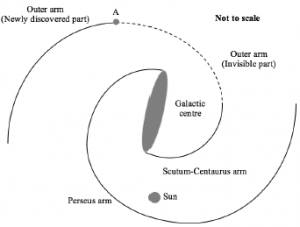2017年IOAA理论第3题-银河系遥远的外围新悬臂
本题目目前没有解答。要不要你来试试! |
|
IOAA赛场上通常是使用英文回答问题,所以建议各位用英文回答本题~
英文原题
(T3) The Milky Way’s Distant Outer Arm [10 marks]
In 2011, Dame and Thaddeus found a new part of the outer arm of the Milky Way by studying the CO line using the CfA 1.2m telescope. They found that the CO line was detected at galactic longitude $$l=13.25^。$$ (marked A in the figure) where it had a radial velocity of 20.9 $$km·s^-1$$ towards the Sun. Assume that the galactic rotation curve is flat beyond 5 kpc from the Galactic centre. The distance between the Sun and the Galactic centre is 8.5 kpc. The velocity of the Sun around the Galactic centre is 220 $$km·s^-1$$.
a) Find the distance from the start of the arm (point A) to the Galactic centre. [7]
b) Find the distance from the start of the arm (point A) to the Sun. [3]
中文翻译
银河系遥远的外围新悬臂
2011年,Dame 和 Thaddeus通过使用哈佛史密松天体物理中心(CfA)的1.2米望远镜研究一氧化碳(CO)射电谱线时发现了新的银河系外围悬臂。他们发现CO线在银经13.25。处(图中的点A处)开始被检测到,此处的日心视向速度为20.9 $$km·s^-1$$。假定星系自转曲线在距星系中心5 kpc处趋于平坦;太阳到银河中心的距离为8.5 kpc;太阳环绕银心的速度为220 $$km·s^-1$$。
(a)计算悬臂起点(点A)到银心到距离。
(b)计算悬臂起点(点A)到太阳到距离。
讨论
这道题官方给出的题目和答案上写的题目在题干部分的表述有一些出入,但是不影响做题。有一个需要注意的地方是“星系自转曲线趋于平坦”,这是做题的一个关键。在解答放出来之前就说这么多吧~ Caroldong(讨论)

